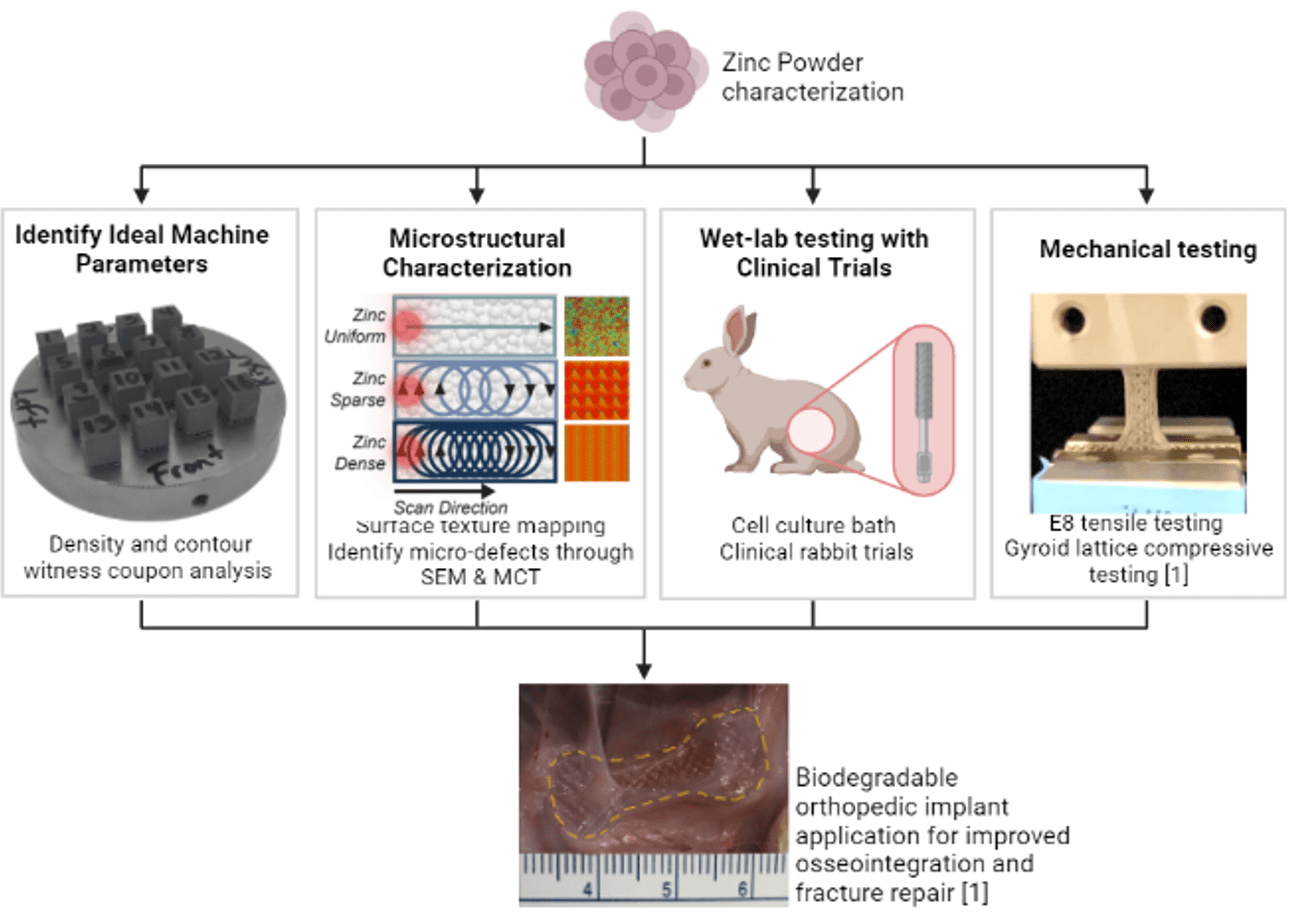Sand Casting
|
Advancing metal casting process via 3D sand printing |
|||||
 |
|||||
| Research Highlights |
|
||||
| Students | Philip King, Md Moinuddin Shuvo | Tools | Flow 3D, Solidcast, nTopology | Manufacturing | ExOne, VoxelJet |
|
Publications (as of May 2023) |
https://doi.org/10.3390/ma16020756 |
||||
Hybrid Manufacturing
|
Abrasive Flow Machining on AM thin walls and internal channels |
|||||
 |
|||||
| Research Highlights |
|
||||
| Students | Sagar Jalui | Tools | Solidworks, Fusion 360, Avizo, ImageJ, Mathematica | Manufacturing | 3D Systems ProX 320 (L-PBF) |
| Publications | http://dx.doi.org/10.26153/tsw/17674 | ||||
|
Additive Manufacturing + Mass Finishing Hybrid Manufacturing System (AM+MF) |
|||||
 |
|||||
| Research Highlights |
|
||||
| Students | Foxian Fan, Sagar Jalui, Kazi Shahed Safowan | Tools | Solidworks, Fusion 360, Keyence, Python | Manufacturing | 3D Systems ProX 320 (L-PBF); Arcam Q20+ |
|
Publications |
http://dx.doi.org/10.26153/tsw/17678 http://dx.doi.org/10.26153/tsw/44335 “Mass Finishing of Additively Manufactured Ti6Al4V Parts: An Investigation of Surface Finish Dependency on Build Orientation and Processing Conditions”. 2023 North American Manufacturing Research Conference (NAMRC) proceedings. Link: Available soon “Cost Analysis of Mass Fishing Additively Manufactured Metal Parts ”. 2023 Institute of Industrial and System Engineers (IISE) conference proceedings. Link: Available soon |
||||
|
Computer vision-based surface morphology evolution through feature tracking for mass finished metal-AM surfaces |
|||||
 |
|||||
| Research Highlights |
|
||||
| Students | Sagar Jalui, Foxian Fan | Tools | Python (Detectron2) | Manufacturing | 3D Systems ProX 320 (L-PBF); Arcam Q20+ |
Design for Additive Manufacturing (DfAM)
| Shape Morphing Metamaterials | |||||
 |
|||||
| Research Highlights | |||||
| Students | Ankit Saxena | Tools | Manufacturing | ||
|
Developing a Novel Test Artifact Design for Conformal Printing via Material Extrusion |
|||||
 |
|||||
| Research Highlights |
|
||||
| Students | Sagar Jalui, Willem Groeneveld-Meijer, Jay Sim, Serah Hatch, Mychal Taylor | Tools | Slic3r | Manufacturing | Prusa MK3 |
| Publication | http://dx.doi.org/10.26153/tsw/44331 | ||||
Triply Periodic Minimal Surfaces (TPMS)
|
Multi-material and geometric gradation and fabrication of TPMS structures through Laser Powder Bed Fusion |
|||||
 |
|||||
| Research Highlights |
|
||||
| Students | Jacklyn Griffis, Buket Yilmaz | Tools | nTopology | Manufacturing | 3D Systems ProX 320 (L-PBF) equip with Aerosint’s Selective Powder Deposition (SPD) recoating chambers. |
|
Design of Non-Pneumatic Tires (NPT) using TPMS |
|||||
 |
|||||
| Research Highlights |
|
||||
| Students | Ankit Saxena, Avez Shaikh | Tools | nTopology, Solidworks, Ansys Mechanical | Manufacturing | 3D Systems Figure 4 Standalone |
Binder Jet Additive Manufacturing
|
Study of multimodal powder-binder interaction in binder jetting process |
|||||
 |
|||||
| Research Highlights |
|
||||
| Students | KaziSafowan Shahed, Willem Groeneveld-Meijer | Tools | Flow3D | Manufacturing | Desktop Metal ExOne Innovent+ |
Biomedical AM
|
Additive manufacturing of patient-specific high-fidelity and thickness-controlled cerebral aneurysm geometries |
|||||
 |
|||||
| Research Highlights |
|
||||
| Students | Sandy Karam | Tools | 3D Sprint, SolidWorks | Manufacturing | 3D Systems Figure 4 Standalone |
|
LPBF of Zinc for biodegradable orthopedic implants |
|||||
 |
|||||
| Research Highlights |
|
||||
| Students | Jacklyn Griffis with Dr. Michael Hast from UPenn | Tools | nTopology, 3D Expert | Manufacturing | 3D Systems ProX 320 (L-PBF) |
|
3D Printing Using Polycaprolactone For Small Bone Fracture Fixation |
|||||
 |
|||||
| Research Highlights |
|
||||
| Students | Rachel Bonfini with Dr. Michael Hast from UPenn | Tools | MSLattice, SolidWorks, PrusaSlicer | Manufacturing | Creality Ender-3 Pro |

